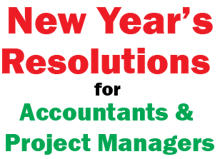The Various Forms of Percent Complete
 At the beginning of 2019, Financial Accounting Standards Board (FASB) and the International Accounting Standards Board (IASB) jointly implemented the Accounting Standards Codification (ASC) 606, Revenue from Contracts with Customers. Essentially, ASC 606 now requires forms to recognize revenue from contracts with customers when goods or services are transferred. For professional services firms that use their expertise to sell their time, this has a significant impact on how firms recognize revenue.
At the beginning of 2019, Financial Accounting Standards Board (FASB) and the International Accounting Standards Board (IASB) jointly implemented the Accounting Standards Codification (ASC) 606, Revenue from Contracts with Customers. Essentially, ASC 606 now requires forms to recognize revenue from contracts with customers when goods or services are transferred. For professional services firms that use their expertise to sell their time, this has a significant impact on how firms recognize revenue.
About FASB ASC 606
With the new guidelines in ASC 606, firms must recognize revenue in their income statement during the period in which the revenue is earned and not when it is billed. Since professional services firms manage projects that can span across multiple periods, they might not bill until the project is complete. As a result, firms must use a form of percent complete for the project to determine how much revenue to state on their income statement for that period. For example, if during a specific period a firm completes 25% of the project, they must recognize 25% of the revenue that will be earned from the contract for that period.
There are three distinct ways to calculate percent complete:
- Billing Percent Complete
- Financial Percent Complete
- Physical Percent Complete
Billing Percent Complete
Using billing percent complete is the most common method. Typically, this is driven by the project manager during the invoicing process. There are two options:
- Overall percent applied to the total contract value
- Percent complete by phase used to invoice based on the various components of scope/deliverables and these phases are broken down using either internal or external contract value
For many firms, this also drives revenue or earnings. Furthermore, it is recommended for people to review the current FASB 606 regulations. This will explain why earning what you invoiced may not be an acceptable solution any longer.
Financial Percent Complete
Another common technique is the financial percent complete. The formula for this method is job to date/job to date + estimate to complete. This indicates how much of the total estimate at completion has been spent or burned. When applied to the contract value, we can calculate revenue. Deltek Vision can facilitate this calculation using Resource Planning.
Physical Percent Complete
Lastly, physical percent complete can be utilized. This is usually calculated when the user or project manager has entered and can provide the following:
- Compared to financial percent complete, indicated whether the project’s progress is tracking with the financial burn
- When begin to drive earned value
- Have control earnings based upon contractual stipulations such as deliverables which can accelerate or slow down earnings and at the same time drive Work in Process (WIP) in tandem but that is separate from invoicing
Which Form is Right for Your Firm?
Let’s do some homework. Using a project your firm is executing, calculate/stipulate all three forms of percent complete and compare them. Then write a business case elaborating on the project’s health from these three statistics. You might surprise yourself with the results.



 2018 was a banner year for mergers and acquisitions (M&As) across the A&E industry. If trends continue, 2019 should be even better. So, what is the driving force behind this increase in deals? Let’s check out why firms want to make these big changes.
2018 was a banner year for mergers and acquisitions (M&As) across the A&E industry. If trends continue, 2019 should be even better. So, what is the driving force behind this increase in deals? Let’s check out why firms want to make these big changes.
 For professional services firms, having the right project lifecycle is essential to having a profitable company. Even more, the processes that drive your firm’s project lifecycle must be in sync with the systems you use to manage them. There are several stages in the project lifecycle and evaluating your processes requires breaking down the steps. In this blog, we’ll look at the initial and most overlooked phase of the project lifecycle…winning the work.
For professional services firms, having the right project lifecycle is essential to having a profitable company. Even more, the processes that drive your firm’s project lifecycle must be in sync with the systems you use to manage them. There are several stages in the project lifecycle and evaluating your processes requires breaking down the steps. In this blog, we’ll look at the initial and most overlooked phase of the project lifecycle…winning the work.
 Mergers and acquisitions (M&A) in the architectural and engineering (A&E) industry are on the rise. Unfortunately, many firms are not prepared to successfully implement the M&A process. With an acquisition, it is imperative that the “buying” entity have a well-defined set of procedures to easily onboard the incoming firm. In the case of a merger, all involved firms would need a set plan which would dictate the transition to a new firm. However, first a firm must decide the direction it will take regarding the M&A process and evaluate how it will affect the current organization’s structure.
Mergers and acquisitions (M&A) in the architectural and engineering (A&E) industry are on the rise. Unfortunately, many firms are not prepared to successfully implement the M&A process. With an acquisition, it is imperative that the “buying” entity have a well-defined set of procedures to easily onboard the incoming firm. In the case of a merger, all involved firms would need a set plan which would dictate the transition to a new firm. However, first a firm must decide the direction it will take regarding the M&A process and evaluate how it will affect the current organization’s structure.
 With the New Year approaching, it is a fitting time for accountants and project managers to review the previous year and identify areas of improvement. While we usually think of New Year’s resolutions for our personal lives, there can also be professional ones. Let’s take a look at some of them.
With the New Year approaching, it is a fitting time for accountants and project managers to review the previous year and identify areas of improvement. While we usually think of New Year’s resolutions for our personal lives, there can also be professional ones. Let’s take a look at some of them. As I travel around and work with clients implementing Vision Resource Planning, the issue of what makes a good project manager (PM) is often discussed. The PM track has always been perceived as a measurement of success in one’s career. As employees become more tenured within a firm, there seems to be a natural progression to the PM role. However, not everyone who is strong technically is able to effectively manage projects. Based on my experience, to be a good PM requires proficiency in certain key areas.
As I travel around and work with clients implementing Vision Resource Planning, the issue of what makes a good project manager (PM) is often discussed. The PM track has always been perceived as a measurement of success in one’s career. As employees become more tenured within a firm, there seems to be a natural progression to the PM role. However, not everyone who is strong technically is able to effectively manage projects. Based on my experience, to be a good PM requires proficiency in certain key areas.
 The following account is a true story. It begins with an AE firm recognizing the need for change in order to support its growth. This firm quickly realized that bringing disparate systems to one integrated platform like Deltek Vision was the fix they needed.
The following account is a true story. It begins with an AE firm recognizing the need for change in order to support its growth. This firm quickly realized that bringing disparate systems to one integrated platform like Deltek Vision was the fix they needed.
 So many people have suggested that I write a book about my travel experiences. After all, I average about 125,000 domestic miles each year and truly believe that, if I decorated my home with cheap hotel art and bolted down my television, my “layover” in Bakersfield, CA would be quite comfortable. Not to mention the miles and miles of test driving countless models of white cars you see in most hotel parking lots. Seriously though, I do love my job, and because it does require me to travel a lot, I have learned much and will now pass some tips on to you.
So many people have suggested that I write a book about my travel experiences. After all, I average about 125,000 domestic miles each year and truly believe that, if I decorated my home with cheap hotel art and bolted down my television, my “layover” in Bakersfield, CA would be quite comfortable. Not to mention the miles and miles of test driving countless models of white cars you see in most hotel parking lots. Seriously though, I do love my job, and because it does require me to travel a lot, I have learned much and will now pass some tips on to you.
 There has been an uptick in interest recently from C-Level financial leaders to become more involved with the CRM functions within Vision. You may ask yourself why this new trend is occurring since the CRM module of Vision is for marketing and business development functions. The reason must surely be based on an informational need so that actionable decisions can be made.
There has been an uptick in interest recently from C-Level financial leaders to become more involved with the CRM functions within Vision. You may ask yourself why this new trend is occurring since the CRM module of Vision is for marketing and business development functions. The reason must surely be based on an informational need so that actionable decisions can be made.
 A KPI, or Key Performance Indicator, is a measurable value that demonstrates how effectively a company is achieving crucial business objectives. Organizations should use KPIs to evaluate their success at reaching targeted goals. Simply stated, KPIs provide your firm with metrics that compare budgeted amounts to the actual values. KPIs are no longer just for accounting and finance as they now reach deeper into a firm’s operational side examining marketing, business development and project management.
A KPI, or Key Performance Indicator, is a measurable value that demonstrates how effectively a company is achieving crucial business objectives. Organizations should use KPIs to evaluate their success at reaching targeted goals. Simply stated, KPIs provide your firm with metrics that compare budgeted amounts to the actual values. KPIs are no longer just for accounting and finance as they now reach deeper into a firm’s operational side examining marketing, business development and project management.